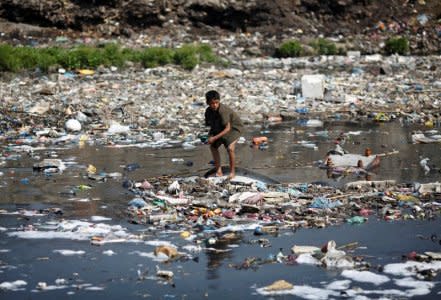Nature's 'alarming' decline threatens food, water, energy: U.N.

Thomson Reuters
By Alister Doyle
OSLO (Reuters) - Human activities are causing an alarming decline in the variety of plant and animal life on Earth and jeopardizing food, clean water and energy supplies, a U.N.-backed study of biodiversity said on Friday.
Pollution, climate change and forest clearances to make way for farmland were among the worsening threats to nature, according to more than 550 experts in a set of reports approved by 129 governments after talks in Colombia.
"Biodiversity, the essential variety of life-forms on earth, continues to decline in every region of the world," the authors wrote. "This alarming trend endangers the quality of life of people everywhere."
Four regional reports covered the Americas, Asia and the Pacific, Africa, Europe and Central Asia - all areas of the planet except the poles and the high seas.
For the Americas, the report estimated that the value of nature to people - such as crops, wood, water purification or tourism - was at least $24.3 trillion a year, equivalent to the region's gross domestic product from Alaska to Argentina.
Almost two-thirds of those natural contributions were in decline in the Americas, it said.
"Biodiversity and nature's contributions to people sound, to many people, academic and far removed from our daily lives," said Robert Watson, chair of the Intergovernmental Science-Policy Platform on Biodiversity and Ecosystem Services (IPBES).
"Nothing could be further from the truth."
ELEPHANTS AND MOSSES
Among other economic estimates, the Africa report said the absorption of greenhouse gases by a hectare (2.5 acres) of forest in Central Africa was worth $14,000 a year.
Around the world, ever more animals and plants were under threat, ranging from elephants in Africa to rare mosses in Europe. More than half of African bird and mammal species could be lost to climate change by 2100, it said.
"By 2100, climate change could ... result in the loss of more than half of African bird and mammal species," said Emma Archer of South Africa, the co-chair of the African assessment.
For pollution, eight of 10 rivers around the world with most plastic waste were in Asia. On current trends, overfishing meant there could be no exploitable fish stocks in the Asia-Pacific region by mid-century.
Rising human populations in many developing nations would require new policies both to protect nature and to meet U.N. goals to eradicate poverty and hunger by 2030.
In Europe and Central Asia, wetlands have declined by half since 1970. The average ecological footprint - or land needed per person for a sustainable environment - was 5.1 hectares against an available 2.2.
Amid the gloom, there were some bright spots.
Forest cover had risen by 22.9 percent in China and other nations in northeast Asia between 1990 and 2015. Parks and other protected areas were expanding in many regions, including the Americas and Asia-Pacific.
And populations of animals such as the Iberian lynx, Amur tiger and far eastern leopard were coming back from the brink of extinction thanks to conservation.
(Reporting by Alister Doyle; Editing by Andrew Roche)
See Also:

 Yahoo News
Yahoo News 
